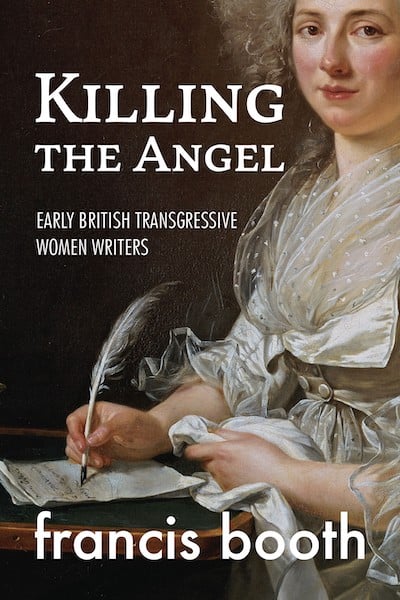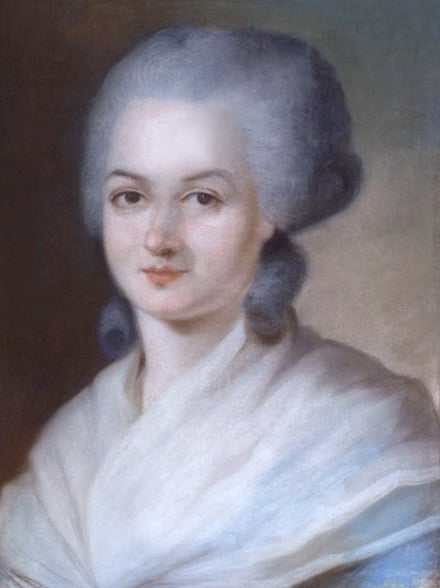Charlotte Lennox, English Novelist, Playwright, and Poet
By Francis Booth | On July 15, 2021 | Updated August 2, 2021 | Comments (0)

Charlotte Lennox (c. 1730 – 1804), née Barbara Charlotte Ramsay, was an English novelist, playwright, and poet best remembered for her 1752 novel, The Female Quixote. This introduction to her life and work is excerpted from Killing the Angel: Early Transgressive British Woman Writers by Francis Booth ©2021, reprinted by permission.
Charlotte had a peripatetic early life. Born in Gibraltar, the daughter of a Scottish captain in the British Army, she lived her first ten years in England before moving to Albany in New York, where her father was Lieutenant Governor.
After her father’s death in 1742, Charlotte remained in New York with her mother until, at age thirteen, she was sent to London to a companion to her aunt. Her aunt, however, seems to have been mentally unstable, so Charlotte became companion to the unmarried courtier Lady Isabella Finch, cousin of the poet Anne Finch, Countess of Winchilsea.
The Countess lived in a splendid, newly built townhouse in Berkeley Square in the fashionable heart of London. Lady Mary Wortley Montagu was a visitor, as was Horace Walpole.
Poems on Several Occasions (1747)
Lennox’s first published volume of poetry, Poems on Several Occasions (1747) was dedicated to Lady Isabella.
Charlotte was preparing to be a courtier herself, but instead married Alexander Lennox, who had very little money. She turned to stage acting on the stage to earn her own living — a very transgressive thing to do. She had some success, but after Poems was published she turned her focus to writing; ‘The Art of Coquetry’ was published in The Gentleman’s Magazine.
Ye lovely maids! whose yet unpractis’d hearts
Ne’er felt the force of Love’s resistless darts;
Who justly set a value on your charms,
Pow’r all your wish, but beauty all your arms
Who o’er mankind wou’d fain exert your sway
And teach the lordly tyrant to obey;
Attend my rules, to you alone addrest
Deep let them sink in every female breast.
. . . . . . . . . .

Killing the Angel on Amazon US*
Killing the Angel on Amazon UK*
. . . . . . . . .
The Female Quixote
Although the women of the Bluestockings seemed to dislike her, Samuel Johnson was an admirer of Lennox and introduced her to all the leading members of the London literary scene; he threw a party to celebrate the publication of her first novel The Life of Harriot Stewart, Written by Herself.
Johnson, Henry Fielding, and Samuel Richardson favorably reviewed her second and most famous novel, The Female Quixote, or, The Adventures of Arabella (1752) which was published anonymously, though its authorship was an open secret. It is a picaresque, a parody of Don Quixote by Miguel de Cervantes, clearly influenced by Fielding’s slightly earlier Tom Jones, 1749.
Fielding had published a play Don Quixote in England in 1734 and the title page of his 1742 Joseph Andrews said it was ‘written in imitation of the manner of Cervantes.’ It’s a precursor to Sterne’s Tristram Shandy (1759 onwards) with its ‘Cervantic humour.’ Like theirs, Lennox’s novel has absurdly long, ironic chapter titles such as:
CHAPTER IV. A Mistake, which produces no great Consequences — An extraordinary Comment upon a Behaviour natural enough — An Instance of a Lady’s Compassion for her Lover, which the Reader may possibly think not very compassionate.
CHAPTER VI. In which the Adventure is really concluded; tho’, possibly, not as the Reader expected.
The Arabella of the title (Arabella is the name of the title character’s older sister in Richardson’s Clarissa, 1748) is something of an idealised woman, educated and cultured, perhaps representing Lennox’ own idealized view of herself.
Nature had indeed given her a most charming Face, a Shape easy and delicate, a sweet and insinuating Voice, and an Air so full of Dignity and Grace, as drew the Admiration of all that saw her. These native Charms were improved with all the Heightenings of Art; her Dress was perfectly magnificent; the best Masters of Music and Dancing were sent for from London to attend her. She soon became a perfect Mistress of the French and Italian Languages, under the Care of her Father; and it is not to be doubted, but she would have made a great Proficiency in all useful Knowledge, had not her whole Time been taken up by another Study.
From her earliest Youth she had discovered a Fondness for Reading, which extremely delighted the Marquis; he permitted her therefore the Use of his Library, in which, unfortunately for her, were great Store of Romances, and, what was still more unfortunate, not in the original French, but very bad Translations.
. . . . . . . . .

. . . . . . . . .
Translations, literary criticism, and plays
Like her character Arabella and some other female writers of the time, Lennox herself learned Italian and translated several Italian works. And, like Elizabeth Montagu, Lennox published a lengthy critical work on William Shakespeare, Shakespear Illustrated, 1753, arguably the first feminist work of literary criticism.
Lennox is mostly concerned with Shakespeare’s sources, but she is also concerned with his female characters; she accuses Shakespeare of ‘taking from them the power and the moral independence which the old romances and novels had given them.’
Her major plays were Philander (1758), The Sister (1769), and Old City Manners (1775).
. . . . . . . . . .

You may also enjoy:
5 Early English Women Writers to Discover
Elizabeth Cary, Early English Poet, Dramatist, and Scholar
The Matchless Orinda: Katherine Philips
Olympe de Gouges: An Introduction
Susanna Centlivre, English Poet and Playwright
. . . . . . . . . .
More novels, and work as an editor
Lennox published four other novels: Henrietta, 1758 (Lennox also wrote a stage play, The Sister based on the novel); Sofia, 1762; Eliza, 1766 and Euphemia, 1790, but during 1761 and 1762 her main literary output was as the editor of and main contributor to the periodical The Lady’s Museum, The Trifler, advertised as being ‘by the author of The Female Quixote.’ The introduction to the first issue runs:
AS I do not set out with great promises to the public of the wit, humour, and morality, which this pamphlet is to contain, so I expect no reproaches to fall on me, if I should happen to fail in any, or all of these articles.
My readers may depend upon it, I will always be as witty as I can, as humorous as I can, as moral as I can, and upon the whole as entertaining as I can. However, as I have but too much reason to distrust my own powers of pleasing, I shall usher in my pamphlet with the performance of a lady, who possibly would never have suffered it to appear in print, if this opportunity had not offered.
If her sprightly paper meets with encouragement enough to dispel the diffidence natural to a young writer, she will be prevailed upon, I hope, to continue it in this Museum; I shall therefore, without any farther preface, present it to my readers.
More about Charlotte Lennox
- Rediscovering Charlotte Lennox
- Charlotte Lennox and the Disciplining of the Female Reader
- Reader discussion on Goodreads
Contributed by Francis Booth,* the author of several books on twentieth-century culture:
Amongst Those Left: The British Experimental Novel 1940-1960 (published by Dalkey Archive); Everybody I Can Think of Ever: Meetings That Made the Avant-Garde; Girls in Bloom: Coming of Age in the Mid-Twentieth Century Woman’s Novel; Text Acts: Twentieth Century Literary Eroticism; and Comrades in Art: Revolutionary Art in America 1926-1938.
Francis has also published several novels: The Code 17 series, set in the Swinging London of the 1960s and featuring aristocratic spy Lady Laura Summers; Young adult fantasy series The Watchers; and Young adult fantasy novel Mirror Mirror. Francis lives on the South Coast of England. He is currently working on High Collars and Monocles: Interwar Novels by Female Couples.
. . . . . . . . . .
*These are Amazon Affiliate links. If a product is purchased by linking through, Literary Ladies Guide receives a modest commission, which helps maintain our site and helps it to continue growing!
Leave a Reply